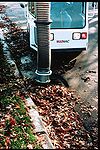
Industrial prevention practices for TP
Industrial prevention practices for TP.
Link to this table
| Practice | Relative effectiveness | Method | Image1 |
|---|---|---|---|
| Better Turf Management | High | Ensure that mowing, fertilization, pesticide application, and irrigation are completed in ways that will prevent or reduce grass clippings, sediment, and chemicals from entering storm sewer systems; use native vegetation where possible. | |
| Proper Vehicle Management | High | Ensure that vehicles are fueled, maintained, washed and stored in a manner that prevents the release of harmful fluids, including oil, antifreeze, gasoline, battery acid, hydraulic and transmission fluids, and cleaning solutions. | |
| Sanitary Sewer Maintenance | High | Regularly inspect and flush sanitary pipes to ensure that there are no leaks in the system and that the system is properly functioning. | |
| Temporary Construction Sediment Control | Moderate | Implement and encourage practices to retain sediment within construction project area; see Temporary Construction Erosion and Sediment Control Factsheets for additional information | |
| Wind Erosion Control | Moderate | Institute a local program for wetting of open construction surfaces and other sources for windblown pollutants. | |
| Material Storage Control | Moderate | Reduce or eliminate spill and leakage loss by properly inspecting, containing, and storing hazardous materials and having a cleanup plan that can be quickly and efficiently implemented. | |
| Dumpster and landfill management | Moderate | Ensure that contaminated material is contained to prevent solid and/or liquid waste from being washed into storm sewer systems or water bodies. | |
| Better Street and Parking Lot Cleaning | Moderate | Maintain streets and parking lots frequently and especially in the spring by sweeping, picking up litter, and repairing deterioration; pressure wash pavement only as needed and avoid using cleaning agents. | |
| Storm Sewer System Maintenance | Moderate | Regularly clean debris from storm sewer inlets, remove sediment from catch basin sumps, and remove any illicit connections to storm sewer systems. |
1 Photo credits
2Reductions in pollutant loading associated with this BMP are not eligible for credit toward NPDES permit requirements unless the stabilization is above the ordinary high water mark (i.e. the work is not completed within a Water of the State), prior to a permittee's discharge, and the load reduced from this action is included in a Wasteload Allocation in a U.S. EPA-approved TMDL.








